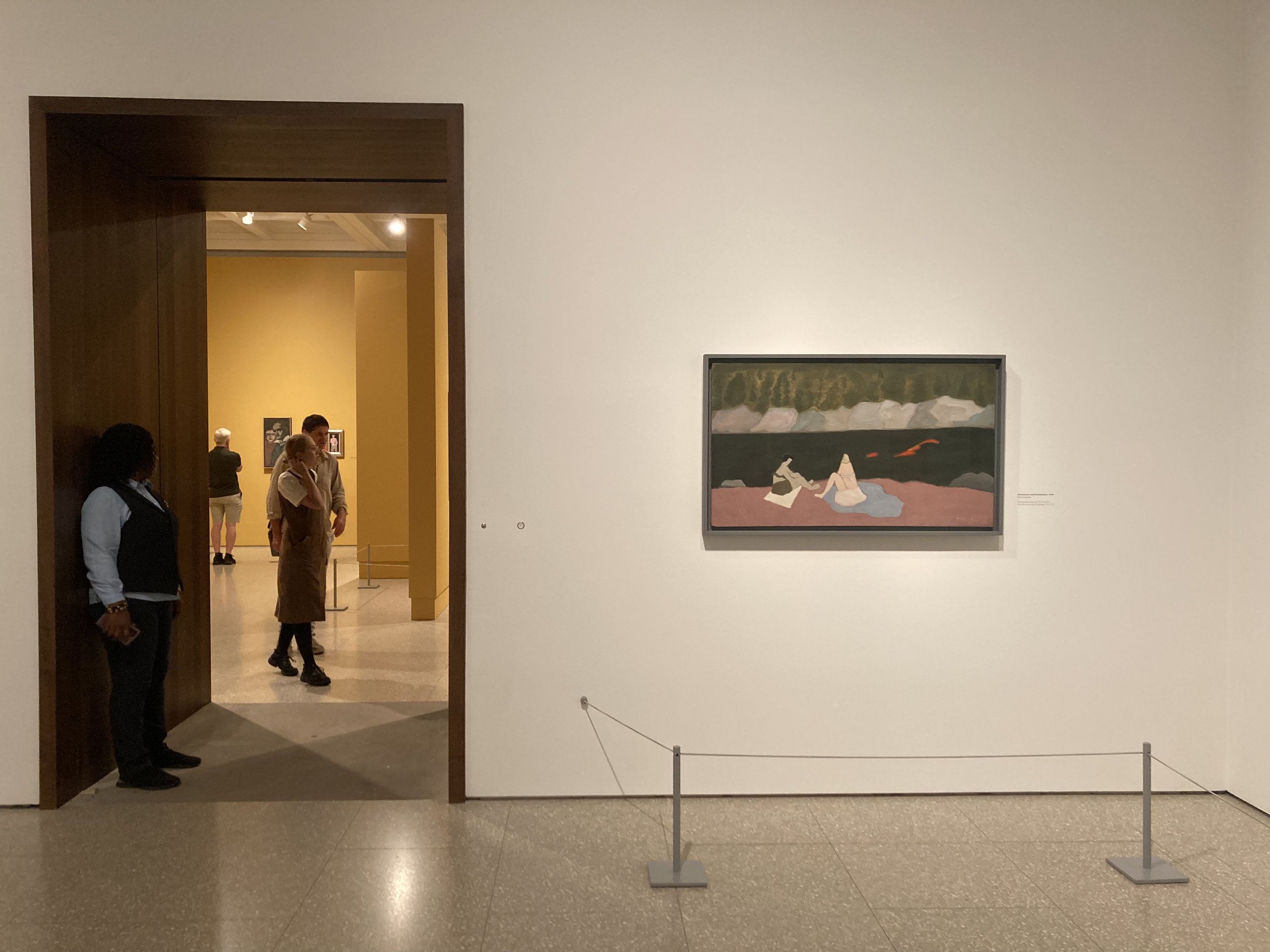Colour Chronicles: Milton Avery @ the Royal Academy
The colour conversation arises a fair bit in art discourse–and for good reason. A powerful form of communication, colours can stimulate feelings, change thought patterns, and even conjure memories. Though many are connoisseurs of colour, there is arguably one champion who stands apart, someone who used colour as a language, a tool, and a vessel for modernist transformation: Milton Avery.
Avery’s retrospective, American Colourist at the Royal Academy was curated by Edith Devaney, advisor to the Milton Avery Trust Waqas Wajahat, and Avery’s grandson and artist Sean Cavanaugh.
Milton Avery, Husband and Wife, 1945, Oil on canvas. © Milton Avery Trust / Artists Rights Society (ARS), New York and DACS, London 2022. Photo credit: Allen Phillips/ Wadsworth Atheneum, courtesy of the Royal Academy.
Spanning three rooms, the retrospective traverses an equal number of eras, each distinguished by differently coloured walls. A curatorial maneuver that may otherwise go unnoticed, the divisive use of colour serves not only to situate the selection of works within a mood, but it substantiates the transitions of years gone by, floating from one stage to the next which, without indication, might otherwise feel too easy.
Exhibition view. Photo by Camille Moreno.
The exhibition commences on a note of sage. Green: the colour of renewal, life, and youth, introduces the viewer to the painter with early incarnations of still lives and landscapes from 1910 to 1945. Avery’s use of impasto paint was learned from the Lawson technique, though he puts his own Impressionist spin on it, capturing his subjects by painting almost entirely en plein air, whether in the countryside or in the city. By 1926 he had moved to New York City with his wife, Sally, painting a wide variety of scenes, from beach-scapes to urban crowds. As his planes flatten and his colours dominate, Avery began to develop his own distinct style.
Milton Avery, Blue Trees, 1945, Oil on canvas. Collection Neuberger Museum of Art, Purchase College, State University of New York, Gift of Roy R. Neuberger. Photo by Camille Moreno.
By the late 1930s, Avery’s career had taken a significant turn, marked by an equally drastic transition from the pale green walls of the first room to the rich marigold of the second. The colour conjures associations of success, optimism, and energy. By now Avery had come into his own style, and had celebrated his first solo institutional show at the Phillips Memorial Art Gallery in Washington, DC, as well as joined the prestigious gallery of Paul Rosenberg & Co.
Exhibition view. Photo by Camille Moreno.
His departure from conventional pictorial language can be seen in his portraiture, which was stripped of sentiment and replaced with a form and colour-centric approach that is characteristic of his work. Regardless of whom he painted, the subject remained just that–a subject–void of idealistically affectionate methods of portrayal. By 1939, the only portraits he painted were of himself.
Milton Avery, Self-portrait, 1941, Oil on canvas. Collection Friends of the Neuberger Museum of Art, Purchase College, State University of New York. Gift from the Estate of Roy R. Neuberger. Courtesy of the Royal Academy.
The third and final room exhibits Avery’s late career, employing the colour of all colours: white. As opposed to perceiving this curatorial choice as an absence of colour, it can alternatively symbolise the clarity that accompanies maturity, its simplicity untainted by any other chroma. It is the colour of light, the colour of canvas, and some say the colour of death.
Milton Avery exhibition view. Photo by Camille Moreno.
The final room focuses on works executed from 1957 onwards, mostly in Cape Cod, where Avery spent his summers in the company of Mark Rothko and Adolph Gottlieb. As he ages, details become less and less important. He fixates his focus entirely on colour and form. Looking back towards the yellow room, the white walls emote a bright, sophisticated backdrop for his most seminal works.
Milton Avery, Sails in Sunset Sea, 1960, Oil on canvas. © Milton Avery Trust / Artists Rights Society (ARS), New York and DACS, London 2022. Courtesy of the Royal Academy.
Avery is believed to have achieved his greatest harmony during these years, balancing colour with his subjects–pancaked landscapes with simplified figures and interlocking planes. As he neared a collision of figuration with abstraction, he managed to keep his agenda clear, which was to capture the “essence of nature.”
Milton Avery, Beach Blankets, 1960, Oil on canvas. Wichita Art Museum, Gift of Marian and S.O. Beren, Wichita, Kanasa. Courtesy of the Royal Academy.
Having risen to height during a time when the artworld was truly local, Avery’s international recognition has been somewhat delayed. Widely acclaimed throughout his home country of the United States, it is only in recent decades that his name has gained notoriety in Great Britain. Accordingly, this exhibition marks his first institutional retrospective in Europe — not only a long overdue recognition of the artist, but perhaps also, for better or worse, a continued flattening of the artworld landscape. Indeed the time is ripe for this champion to be celebrated.
American Colourist is on view through 16 October at the Royal Academy in London.
Camille Moreno
Features Co-Editor, MADE IN BED









